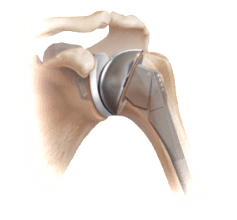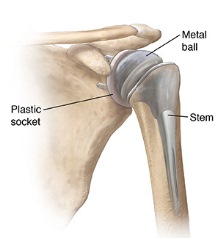Joint Replacement
The medical procedure in which the parts of an arthritic or injured joint are detached and replaced with a metal, plastic or ceramic device called prosthesis is known as Total Joint Replacement. This surgical practice aims at restoring the normal functioning of the joint by replicating its movement through the prosthesis. This surgery allows the individual to enjoy their healthy and normal lifestyle after the replacement.
A joint is that point where the extremes of two bones meet. Our body is composed of various joints, which conduct the free movement of our body. Each joint has a specific role and together they are very essential for the smooth physical functioning of our body. Joint replacements are very common and are easily carried out by trained professional surgeons. Hip and knee replacements are the joints, which are generally replaced through surgeries.
Joint Replacement

joint Replacement Center

Causes –
There are numerous scenarios, which might demand for a particular joint to be replaced. Signs like malfunctioning of a joint, disability caused in the joint or immense pain must be followed by taking doctor’s appointment and consultation. In numerous cases, the pain in joints is caused due to the damage in cartilages, which are present in the form of linings at the extreme ends of the bones. Arthritis and fractures are also common reasons, which cause ailment in the joints, and in numerous cases, they are treated with total joint replacement.
Some of the prominent reasons for joint pain are –
Arthritis –
This is the most common reason for pain in joints. It has two forms, namely – osteoarthritis and rheumatoid arthritis. Osteoarthritis is mostly prominent amongst adults who have crossed the age of forty years. It evolves with a slow pace and affects the most commonly used joints namely, the wrists, hands, hips and knees. The pain caused by this kind of arthritis is a result of the breakdown of cartilages.
These cartilages function as a cushioning, which absorbs shock for the joints. The absence of this cushioning causes rough friction amongst the joints and in turn results in pain and stiffness. The second kind of arthritis i.e. rheumatoid arthritis is very common and does not have a particular target age group. However, it tends to affect women more than men. It deforms the joints and debilitates them over passing time. This causes inflammation accompanied by brutal throbbing. This throbbing is a result of the body’s defense mechanism as it attacks the joint lining membrane when it is only supposed to target the fluid that is accumulated between the joints
Bursitis –
There are fluid filled sacs present in our joints and are knows as brusae. They are situated around the area where there is the presence of tendons, skin and muscle tissue together meeting the bones. The main function of these sacs is to provide lubrication between our muscles and scale down the friction between them. Bursitis occurs when the brusae suffer inflammation, which leads to ache, and uneasiness in that particular affected region. It is marked by pain, swelling and redness. It has various forms and causes pain ranging from normal bearable one to that which causes ill functioning of the joint tends to be chronic.
Tendinitis –
The thick cords, which join our muscles to our bones, are known as tendons. When these bonding muscles are disturbed or suffer inflammation, the condition is known as tendinitis. This causes sharp pain and tenderness in the affected region and makes it tough for the joint to function properly. It can occur in various joints but the most prominent ones are shoulder, knee, heels and the wrist. Athletes tend to have this issue more than others because of the constant repetition of similar motions while playing their sport.
Osteoporosis-
This is a situation, which are also known as porous bones. In osteoporosis, the small spaces present in a bone tend to increase and this leads to loss in bone density and its strength. This occurrence on the inside of the bone is reflected in the form of weakness and thinness on the outside of the bone. This disease is not limited to a particular division but is more prominent in people who belong to the old age group. This defect causes bone breakages and fractures while reducing the resistance of the bones to bear with simple movements and causing stern sting while performing them.
Diagnosis –
Total Joint Replacement is carried out only when other means of medication tend to fail or the root cause of the ailment is chronic and needs immediate action. To figure out if any of these is the case, the surgeon diagnoses the knee, carries out a detailed study of the patient’s past medical records and then concludes as to whether or not the surgery is required.
Here are the basic steps, which are carried out while diagnosing a patient –
After all these steps are done, the surgeon will provide final details to the patient and inform them about the actual process of the surgery and its outcome.
Procedure –
Total joint replacement is not a very lengthy procedure and requires just a few hours to be completed. It is carried out in a hospital or in a certified surgery centre by a trained professional surgeon. The injured cartilage and the affected bone is removed from the joint and is replaced with a prosthetic component made of elements: metal, plastic or ceramic. The material of the prosthetic might depend upon factors: price, duration and consultation by the surgeon. Prosthetics are intricately designed in a detailed manner so that they can imitate the shape, form and working of the original natural joint. After the replacement is completed, the doctor will give you a particular diet plan, medicines and will guide you with certain routines and caution points that would be required to be followed after the surgery.
Risks and complications –
During the consultation, your surgeon will inform you about the risks, which might accompany your total joint replacement surgery. Some of these risks might be common while some might be subjective, depending upon the patient’s medical records and other crucial pointers related to their health. Some of the risks involved in total joint replacement are blood clots, infections and nerve injuries. The complications include loosening of the prosthetics or its dislocation from the required spot. The surgeons try their best to treat these complications and resist the risks, which might prevail.
Frequently asked questions
Patients who have severe pain in the joints and face difficulty in conducting movements through them need to consult the doctor. After the examination the doctor decides, whether the surgery is required to be performed or not.
The doctors inject the target area with anesthesia. However, the surgery is still painful, but the scale of pain suffered is subjective to the area where the joint is being replaced and might differ from a person to person.
Post surgery the joint must not be subjected to a lot of stress or exertion. No other surgical procedure must be conducted on the patient freshly after the joint replacement surgery.
Recovery after the total joint replacement surgery is a slow and steady process. However, to make sure that the recovery is carried out well, one must strictly adhere to the diet, medication and exercises prescribed by the surgeon.
